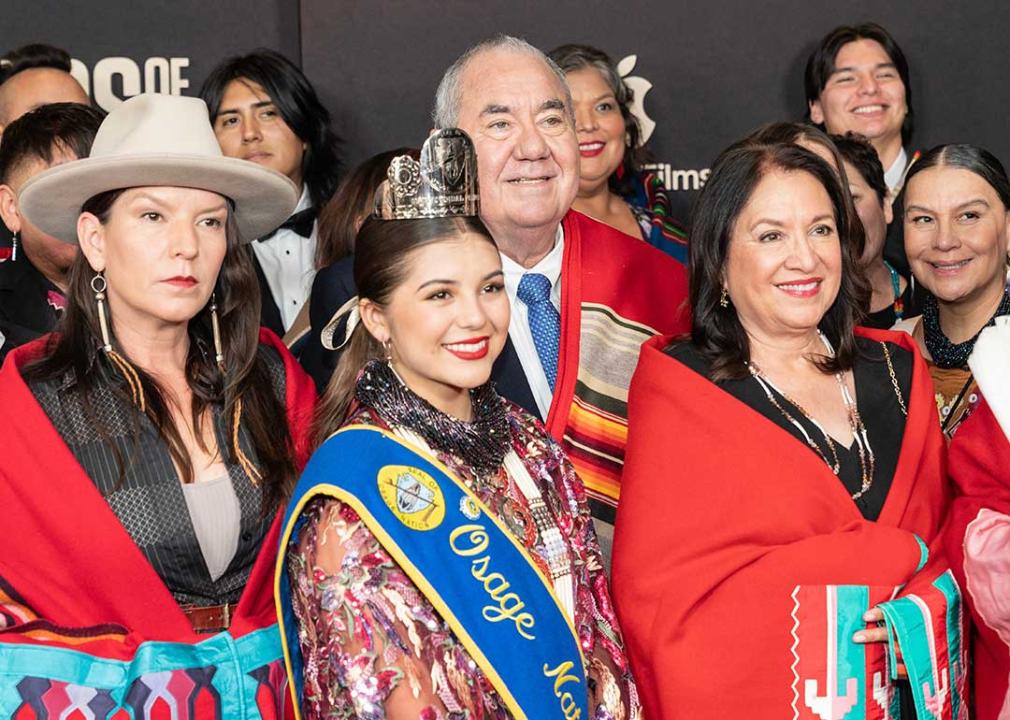Osage history comes to Hollywood in 'Killers of the Flower Moon'

shutterstock
Osage history comes to Hollywood in ‘Killers of the Flower Moon’
Members of Osage Nation attend premiere of the movie Killer os the Flower Moon at Alice Tully Hall in New York
With a $23 million opening weekend at the U.S. box office, “Killers of the Flower Moon” received generally positive reviews praising the film’s director and story. The film centers around the targeted murders of Osage Indian people after oil deposits are discovered on their lands in 1920s Osage County, Oklahoma, near Fairfax and Pawhuska.
The film’s budget was reported at $200 million, making the “Killers of the Flower Moon” project the most expensive film shoot in Oklahoma history. The film’s story takes influence from the 2017 book “Killers of the Flower Moon: The Osage Murders and the Birth of the FBI” written by David Grann. The film differs from the book, however, in that it includes Osage involvement and their culture is well presented. The Daily Yonder looks at the cultural and local impact from Hollywood’s retelling of a dark chapter in Oklahoma’s past.
Beyond the History Books
When people found out that a movie was going to be filmed in Fairfax and Pawhuska by Martin Scorsese, and would include the acting talents of Leonard DiCaprio and Robert DeNiro, there was excitement for a Hollywood production coming to town.
“It was huge,” said Victoria Gawhega, who’s an extra in the film, when she found out that Martin Scorsese was slated to direct a new film on the Osage murders in Osage County. “All these amazing actors, also on board, was mind-blowing.”
Gawhega is Osage, Iowa, and Otoe — all Oklahoma-based tribes — and lives in Pawhuska, a town of around 2,900 about 30 miles from Fairfax. Working as an extra was tough, she said, where long hours of sitting or standing to re-do scenes left blisters on her feet. While growing up in the community, she recalls hearing of the murders that targeted more than 60 people from the Osage tribal community.
Scorsese’s adaptation is just that, an adaptation, and includes an interpreted perspective of Mollie Burkhart, played by Blackfeet actress Lily Gladstone, and the Osage people. The film spans three and a half hours, and centers largely on the relationship between Ernest Burkhart, played by DiCaprio, and his Osage wife, Mollie, while members of her family are targeted and killed by arrangements organized by her husband. The Osage murders are largely masterminded by Ernest’s uncle, William Hale, played by DeNiro.
“You grew up hearing about the Osage murders from the Osage people, not in history books,” Gawhega said to the Daily Yonder. “When you actually see the story in the film, it’s heartbreaking. It gives you a different perspective, and [it’s] very hard to watch when you grew up hearing the stories.”
Narrative Arc of Justice
Federal Indian law, including criminal prosecution on Indian lands, looked very different in 1920s Oklahoma from today. Back then, serious crimes, such as murders committed on Indian lands, were not investigated by the state, in this case Oklahoma, but were rather investigated and prosecuted by the federal government. Criminal jurisdiction fell in the hands of the Bureau of Investigation (BOI) and little funding was appropriated for Indian Country investigations. Today, criminal jurisdiction on Indian lands in Oklahoma has shifted since 2020’s landmark McGirt ruling in the Supreme Court, which said that Congress never disestablished certain reservations and, therefore, Oklahoma does not have jurisdiction on Indian lands. Today, federal, state, and tribal governments share jurisdiction on Indian lands, and which jurisdiction will resume prosecution varies depending on who committed a crime and what type of crime was committed.
The film’s story includes efforts by the Osage people to get justice, including Mollie’s attempts to lobby President Coolidge to send investigators to look into what the Osage people call “The Reign of Terror.” Other means of seeking justice were met with violence, as private investigators or those sent on behalf of Osage people were murdered for their service. If not for Mollie’s advocacy, the Osage may have never received any justice. This is a change of pace in portrayals of Native characters, largely because it centers around an Osage woman.
In the end, we learn of the Osage getting some justice by way of a radio show. Burkhart and Hale are eventually convicted and receive life sentences, but would later be paroled. Mollie would remarry, and die at the age of 50 from diabetes, an ailment her character is seen battling in the film.
Gladstone has already received rave reviews and is seen as an early contender for the next awards season, including an Oscars campaign for “Best Actress.” If she gets a nomination, she will be the first Native American actress to contend for that award.
There are various scenes in the film where Fairfax is visibly seen in signage, and it is also where much of the film was shot. Today, the town has a population of about 1,300 and is bustling with tourism, commerce, and interest from “Killers of the Flower Moon.”
“Our towns are thriving once again,” said Gawhega, who lives in Pawhuska.
When asked about the film’s production being set in small-town Oklahoma, Chance Rush, who plays William “Bill” Stepson in the film, said it was way overdue. “When I thought about the production being in Little Pawhuska, Oklahoma, it made me thankful to know that they went back to the homeland where all of this happened.”
During production, some businesses in both Fairfax and Pawhuska suffered as the town was closed while filming. However, they didn’t go out of business and still got paid by the production.
Killers of the Flower Moon is currently playing in theaters.
This story was produced by Daily Yonder and reviewed and distributed by Stacker Media.
![]()
